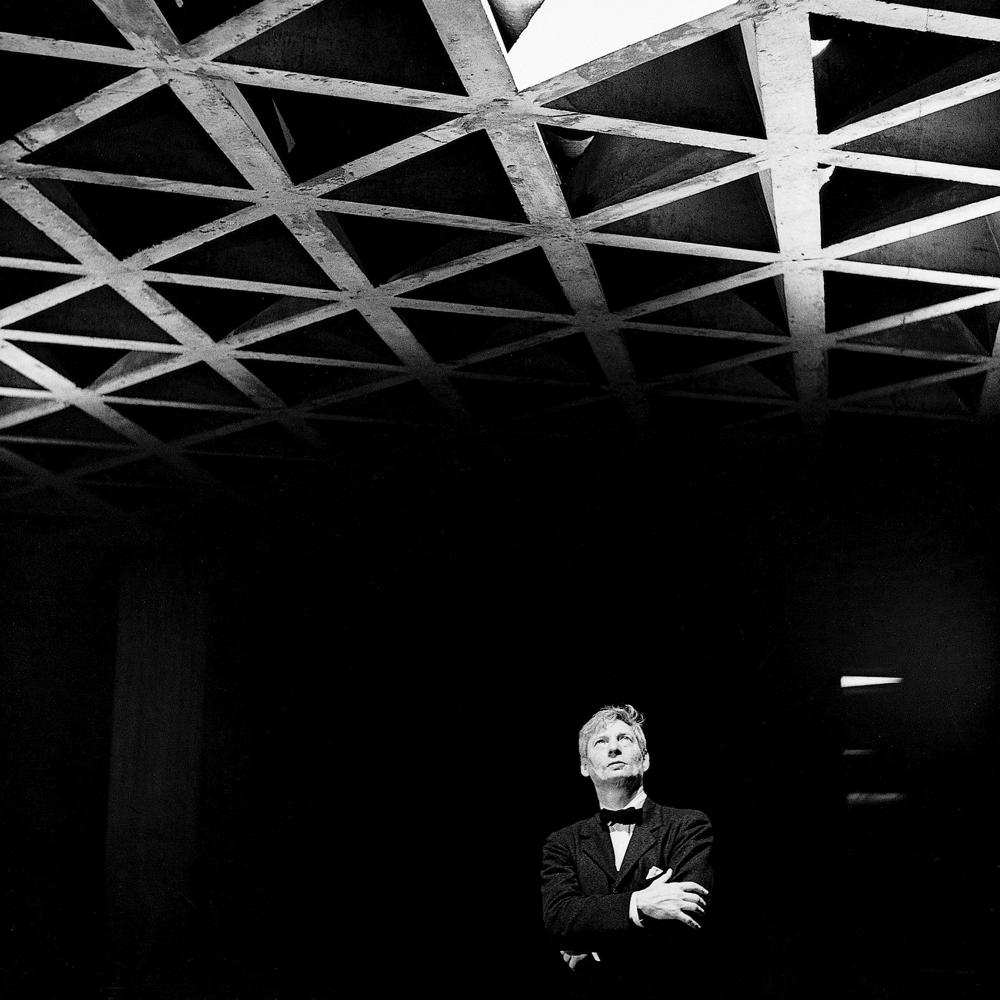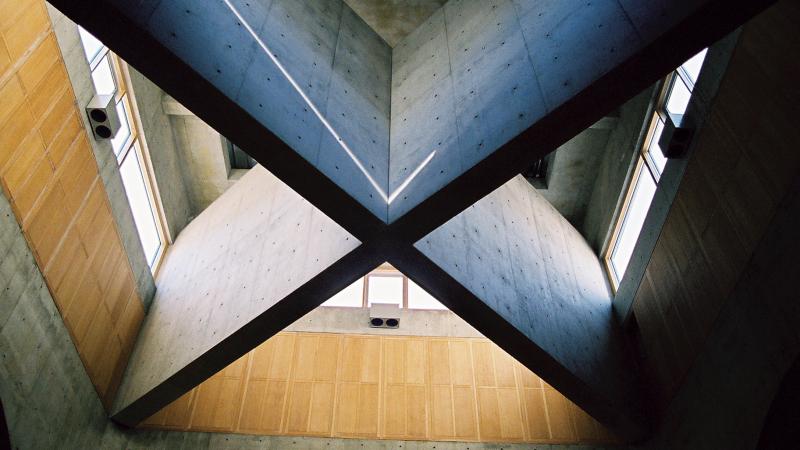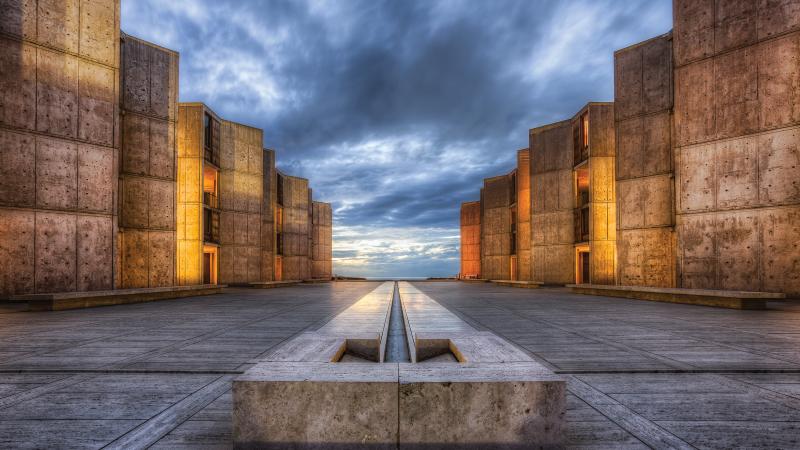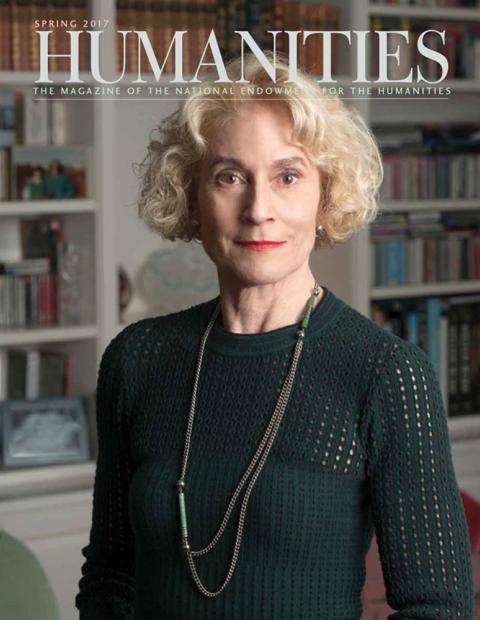You say to brick, “What do you want, brick?” Brick says to you, “I like an arch.” if you say to brick, “arches are expensive and I can use a concrete lintel over an opening. What do you think of that, brick?” Brick says: “I like an arch.” —Louis Kahn
When Louis Kahn’s first partner, George Howe, left for Washington in 1942 to become the supervising architect at the Public Buildings Administration, the partnership was renamed Stonorov & Kahn, but its focus remained worker housing. Over the course of their six years in business together, Louis Kahn and Oscar Stonorov designed seven worker communities, of which five were ultimately built, yielding more than two thousand units of new housing. They also did an innovative if unbuilt hotel design for a project called “194X,” a series sponsored by Architectural Forum that put them in excellent company and brought them substantial attention.
By all accounts, Oscar did the bulk of the promotion and client-getting while Louis concentrated on the actual designs. Despite their personality differences and the fact that, as Kahn’s wife, Esther, put it, “they were both too much of a primadonna,” this arrangement worked for a time, because each was clearly better than the other at his assigned task. It was only when Kahn began to chafe under Stonorov’s dubious approach to shared credit that the partnership finally broke up.
In design terms, the period with Stonorov did not lead to any spectacular work on Kahn’s part. Though some of the projects received significant attention from within the architecture profession, none of the completed structures were more appealing or interesting than the wood-and-stone house Kahn had designed for his friends Jesse and Ruth Oser or the Jersey Homesteads housing he had done under German-born architect Alfred Kastner. But the founding of the new partnership did allow him to bring in a real income for the first time since his Resettlement Administration job had ended. In 1941, the gross receipts of Howe, Stonorov & Kahn were $33,449.99, of which Kahn’s equal partnership share (after $26,206.23 in expenses had been deducted) was $2,281.58. When added to the additional $2,020.84 he had made through Howe & Kahn, that year’s income from his architecture practice was $4,302.42—a substantial addition to the annual $1,650 to $1,800 that Esther was regularly pulling in from Jefferson Medical College. Louis and Esther filed separate tax returns that year, as they generally did throughout the 1940s, and he took their daughter, Sue Ann, as his dependent because he could better use the deduction. (In 1944, by contrast, they filed jointly, with Esther Kahn named as the primary taxpayer on the basis of her $1,800 salary, and with both Sue Ann and Louis listed as her dependents, since he had no partnership income at all that year. Apparently even the war-fueled construction of worker housing could be an up-and-down affair, with no guarantee of regular payment.)
But there were other benefits besides financial ones to working in a real office, and one of them was camaraderie. Peter Blake, one of the early employees of Stonorov & Kahn, recalled a particular Sunday in the summer of 1941 when he, Lou, and two of the other men from the firm drove out to New Jersey in an open convertible to inspect a construction site. Returning to the overly warm streets of Philadelphia at about six p.m., they decided they needed a few cold beers. “Well, in those days Philadelphia was closed down tight on Sundays,” Blake reported, “and so, as we pulled up to stop at a traffic light, I asked a guy in a car next to ours where you could get a drink in Philadelphia on a Sunday. ‘No problem,’ he said. ‘Go to the 6th Ward Republican Club and tell them I sent you.’”
The address the man directed them to turned out to be a one-story house on Locust near Broad. “Who are you?” asked the manager of the club, and Lou loftily assured him, “We’re all Harvard men.” Temporarily abandoning their staunch Democratic principles, the four colleagues paid a dollar each to join the Republican Party. They then made their way into a long, dingy room and ordered a round of beers. An old upright piano was standing on a platform at one end, and according to Blake, “Lou went over to the piano, sat down on the stool, and starting playing Gershwin’s ‘Rhapsody in Blue,’ with enormous energy, enthusiasm, and passion. The whole place began to shake—Lou had very large, very strong hands. He could crush your fingers in a handshake, and he could turn a piano into sawdust if he really tried. That night he was in great form.” A few minutes later, though, the hotel across the street called to say they had a guest who was dying and could the pianist please tone it down. Lou complied instantly, but he continued to play the same tune softly and gently, as if to himself. When an ambulance eventually arrived, Lou called the hotel to see how the patient was. Receiving his answer, he returned to the piano and, to the delight of the other guys, played one last round of “Rhapsody in Blue” at full, rafter-shaking blast.
For Kahn, such moments of conviviality were an extension of the feeling he got from architecture in general—the sense that it was a group effort, a pleasurable back-and-forth, with everyone putting in his two cents’ worth. But there was another side to the work that was more solitary, more self-contained, and this too developed during his years with Stonorov & Kahn. For it was in this period, the early 1940s, that Lou established himself as a published writer, an architect who thought in terms of words on the page as well as buildings in space.
Kahn’s first two publications, issued jointly with Oscar Stonorov, were pamphlets that the two men produced under the sponsorship of the Revere Copper and Brass company. The earlier one, Why City Planning Is Your Responsibility, was a slim 14-page booklet that came out in 1943. Prefaced by a forward-looking wartime note from the president of Revere (“All of us are now working for Uncle Sam. No copper is available except for war. But in Revere’s laboratories, research is hard at work in a dozen different directions so that we can bring better living to millions more after the war is won”), the pamphlet had a friendly yet insistent tone. “If city planning, of which everyone speaks, is ever going to become a reality and bring results, it must become the thing in which YOU—reader of this pamphlet—are vitally interested,” it began. “Because city planning concerns YOUand YOUR neighborhood—and also the fellow that lives a little bit further away from your immediate vicinity . . . YOU, Mr. John Q. Public, should make yourself heard.”
The booklet contained a number of anodyne, if true, generalizations (stressing, for instance, “the human values that are the most important of all in any city planning project”), but it also took issue with certain pieties of the time. It did not advocate annihilating all slums; on the contrary, it suggested that certain “not-quite blighted neighborhoods,” though visibly in decline, should be protected and strengthened as “conservation areas” rather than destroyed wholesale. The authors had specific ideas for the ways in which life could be improved for city dwellers, which included converting unnecessary streets to playgrounds for children and adding real shopping areas in place of “inferior corner stores.” They urged their imagined readers to “Take Action!” by forming their own neighborhood planning groups, and promised that if these methods succeeded, “You won’t have to pull up stakes and seek for so-called better pastures in the suburbs.”
At the end of the pamphlet, under the joint signatures of Oscar Stonorov and Louis Kahn, there was a photo of the two authors, identically dressed in white shirtsleeves and dark ties. Standing next to each other, they both looked out a nearby window, the bald one taller by at least a head, his hand on the shoulder of the smaller man, Kahn, who was smiling gently and smoking thoughtfully on a pipe. Like figures in a Social Realist painting—though dressed in modern capitalist garb—Kahn and Stonorov appeared to be looking toward an enlightened future.
You and Your Neighborhood, which came out a year later, was a more sophisticated effort, though still worded “in terms that we hope make sense to average people,” as Stonorov and Khan put it in their brief introduction. Subtitled “A Primer for neighborhood planning,” this larger pamphlet contained over 80 unnumbered pages, filled with various kinds of illustrations—from photos and cartoons to street diagrams and architectural plans—as well as punchy lists of common problems and their likely solutions. Under bold-faced headings like “Your house and your block,” “Organize a neighborhood planning council,” and “Alone you are powerless,” the authors offered a series of very specific recommendations for how to organize a neighborhood, set up headquarters, and contact those with the power to do something. Their list of “neighborhood needs” included safe streets, playgrounds, a modern school, a place for teenagers to gather, and a shopping center. The underlying impulse was still an exhortation to communal action, but unlike the previous Revere booklet, this one rarely descended to abstract platitudes. Instead, it relied on a sequentially executable outline of plans and activities. It continued, though, to emphasize the core connection between the individual and larger urban unit, between the family and the neighborhood. “The plan of a city should be as orderly as the plan of a house,” the booklet concluded, noted in an almost poetic envoi:
Cities have too few corridors
Cities have beds in their kitchens
Cities have their kitchens in all parts of the house
Cities have crammed living rooms or none at all
These are conditions you can help to change in your own city. From neighborhood, to community, to city—it’s a big job, a long job, but by no means impossible if you will help to start it, and stay to finish it.
This was recognizably the same “you” that Stonorov and Kahn had been addressing all along, but the shrill enthusiasms of their first pamphlet had by now been toned down into somewhat more measured phrases.
More measured still, while also much more idiosyncratic and in many ways more impenetrable, was the sole piece of individual writing that Kahn produced during this time. Titled “Monumentality,” this essay originally appeared in a 1944 collection called New Architecture and City Planning: A Symposium, edited by Paul Zucker. What was striking about it, in retrospect, was how many of Lou’s mature architectural ideas appeared in embryonic form in this, his first major piece of writing.
“Monumentality in architecture may be defined as a quality, a spiritual quality inherent in a structure which conveys the feeling of its eternity, that it cannot be added to or changed,” the essay began. While Kahn was explicitly referring to the Parthenon and other monumental works of the past, such notions also seem evocative of the monuments he himself would eventually produce, from the Salk Institute to the Kimbell Art Museum to the Bangladesh National Assembly. Even his specific comments about structure and materials at times appear to refer to these as-yet-unimagined buildings, as when he said, “Structural problems center about the roof. The permanence and beauty of its surfaces is a major problem confronting science,” or observed, “The giant major skeleton of a structure can assert its rights to be seen. It need no longer be clothed for eye appeal,” or singled out reinforced concrete as a material that was “emerging from infancy” and moving toward “its ultimate refinement.” Yet even as he championed modern construction materials like concrete, steel, glass, and plastic along with the new engineering techniques available for shaping them, he insisted that ancient monuments still had value for twentieth-century architects. While arguing that old forms such as Gothic cathedrals and Greek temples should not merely be duplicated—that the past, in that sense, could not be appropriated or made to live again—Kahn still felt that “we dare not discard the lessons these buildings teach for they have the common characteristic of greatness upon which the buildings of our future must, in one sense or another, rely.”
But the way to arrive at that greatness would by no means be obvious. Unlike the exhorting pamphlets he wrote with Oscar Stonorov, this essay of Kahn’s had few if any specific recommendations, in part because the things he was advocating in the Revere booklets—overt and conscious action—would not necessarily succeed in this other arena. “Monumentality is enigmatic,” Kahn observed. “It cannot be intentionally created.” What he seemed to be suggesting, even at this early stage, was that the architect could not simply impose his own egotistically ambitious, monument-seeking will on the material and the design. Instead, the modern designer or engineer needed to remain receptive to the kind of power that could only emerge organically from his chosen materials as he shaped them toward their specific functions. Such passive receptivity was the very opposite of the virile assertiveness that characterized contemporary architects in the popular imagination—in Ayn Rand’s The Fountainhead, for instance, which had just come out the previous year. What Lou seemed to be advocating in his obscure little essay seemed, by contrast, positively feminine.




